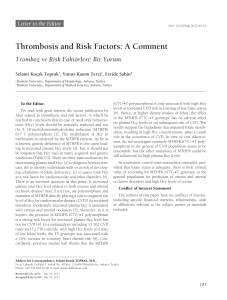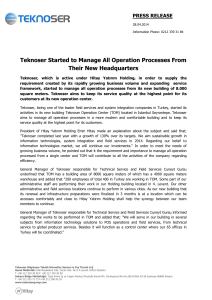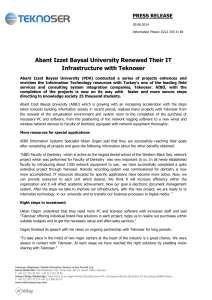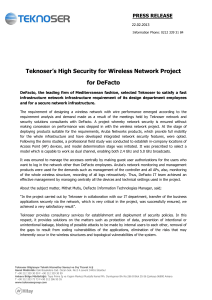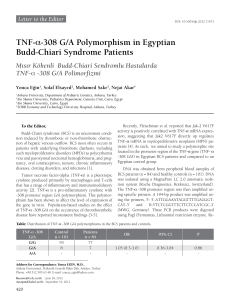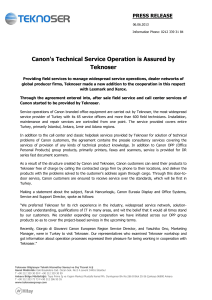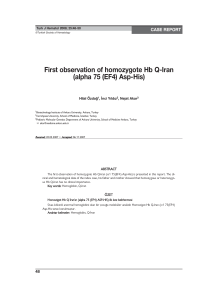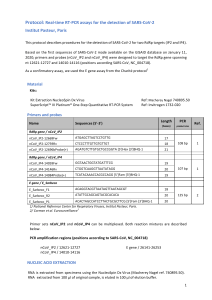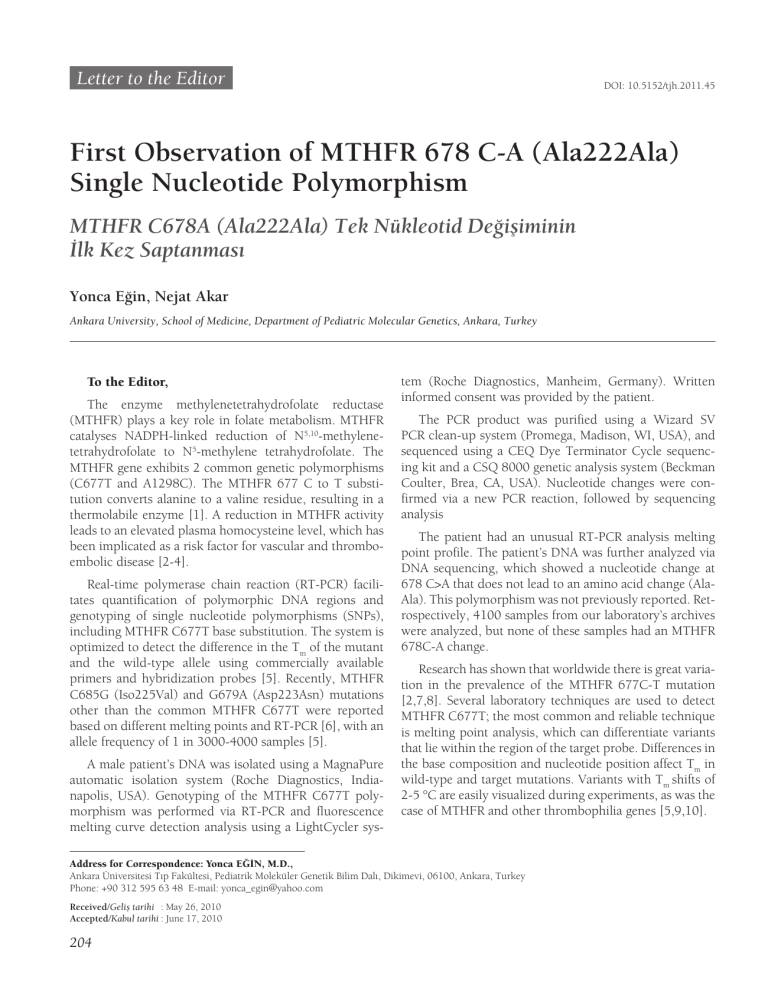
Letter to the Editor
DOI: 10.5152/tjh.2011.45
First Observation of MTHFR 678 C-A (Ala222Ala)
Single Nucleotide Polymorphism
MTHFR C678A (Ala222Ala) Tek Nükleotid Değişiminin
İlk Kez Saptanması
Yonca Eğin, Nejat Akar
Ankara University, School of Medicine, Department of Pediatric Molecular Genetics, Ankara, Turkey
To the Editor,
The enzyme methylenetetrahydrofolate reductase
(MTHFR) plays a key role in folate metabolism. MTHFR
catalyses NADPH-linked reduction of N5,10-methylenetetrahydrofolate to N5-methylene tetrahydrofolate. The
MTHFR gene exhibits 2 common genetic polymorphisms
(C677T and A1298C). The MTHFR 677 C to T substitution converts alanine to a valine residue, resulting in a
thermolabile enzyme [1]. A reduction in MTHFR activity
leads to an elevated plasma homocysteine level, which has
been implicated as a risk factor for vascular and thromboembolic disease [2-4].
Real-time polymerase chain reaction (RT-PCR) facilitates quantification of polymorphic DNA regions and
genotyping of single nucleotide polymorphisms (SNPs),
including MTHFR C677T base substitution. The system is
optimized to detect the difference in the Tm of the mutant
and the wild-type allele using commercially available
primers and hybridization probes [5]. Recently, MTHFR
C685G (Iso225Val) and G679A (Asp223Asn) mutations
other than the common MTHFR C677T were reported
based on different melting points and RT-PCR [6], with an
allele frequency of 1 in 3000-4000 samples [5].
A male patient’s DNA was isolated using a MagnaPure
automatic isolation system (Roche Diagnostics, Indianapolis, USA). Genotyping of the MTHFR C677T polymorphism was performed via RT-PCR and fluorescence
melting curve detection analysis using a LightCycler sys-
tem (Roche Diagnostics, Manheim, Germany). Written
informed consent was provided by the patient.
The PCR product was purified using a Wizard SV
PCR clean-up system (Promega, Madison, WI, USA), and
sequenced using a CEQ Dye Terminator Cycle sequencing kit and a CSQ 8000 genetic analysis system (Beckman
Coulter, Brea, CA, USA). Nucleotide changes were confirmed via a new PCR reaction, followed by sequencing
analysis
The patient had an unusual RT-PCR analysis melting
point profile. The patient’s DNA was further analyzed via
DNA sequencing, which showed a nucleotide change at
678 C>A that does not lead to an amino acid change (AlaAla). This polymorphism was not previously reported. Retrospectively, 4100 samples from our laboratory’s archives
were analyzed, but none of these samples had an MTHFR
678C-A change.
Research has shown that worldwide there is great variation in the prevalence of the MTHFR 677C-T mutation
[2,7,8]. Several laboratory techniques are used to detect
MTHFR C677T; the most common and reliable technique
is melting point analysis, which can differentiate variants
that lie within the region of the target probe. Differences in
the base composition and nucleotide position affect Tm in
wild-type and target mutations. Variants with Tm shifts of
2-5 °C are easily visualized during experiments, as was the
case of MTHFR and other thrombophilia genes [5,9,10].
Address for Correspondence: Yonca Eğin, M.D.,
Ankara Üniversitesi Tıp Fakültesi, Pediatrik Moleküler Genetik Bilim Dalı, Dikimevi, 06100, Ankara, Turkey
Phone: +90 312 595 63 48 E-mail: [email protected]
Received/Geliş tarihi : May 26, 2010
Accepted/Kabul tarihi: June 17, 2010
204
Turk J Hematol 2012; 29: 204-205
In the present study we reported a new heterozygous
MTHFR gene polymorphism (678 C>A), with an unusual
melting point profile. Although rare, the finding of MTHFR
678C>A polymorphism indicates that this might be technically important, as it may lead to erroneous reporting.
Conflict of Interest Statement
The authors of this paper have no conflicts of interest,
including specific financial interests, relationships, and/
or affiliations relevant to the subject matter or materials
included.
References
1. Frosst P, Blom HJ, Milos R, Goyette P, Sheppard CA,
Matthews RG, Boers GJ, den Heijer M, Kluijtmans LA,
Van den Heuvel LP, Rozen R: A candidate genetic risk
factor for vascular disease: A common mutation in
methylenetetrahydrofolate reductase. Nature Genet 1995;
10: 111-113
2. Guba SC, Fink LM, Fonseca V: Hyperhomocysteinemia.
An emerging and important risk factor for thromboembolic
and cardiovascular disease. Am J Clin Pathol 1996; 106:
709-722
3. Clarke R, Daly L, Robinson K, Naughten E, Cahalane
S, Fowler B, Graham I: Hyperhomocysteinemia: an
independent risk factor for vascular disease. N Eng J Med
1991; 324: 1149-1155
Eğin Y and Akar N: MTHFR 678 C-A (Ala222Ala) Change
4. Boers GH, Smals AG, Trijbels FJ, Fowler B, Bakkeren
JA, Schoonderwaldt HC, Kleijer WJ, Kloppenborg PW:
Heterozygosity for homocystinuria in premature peripheral
and cerebral occlusive arterial disease. N Engl J Med 1985;
313: 709-715
5. Lyon E: Discovering rare variants by use of melting
temperature shifts seen in melting curve analysis. Clin Chem
2005; 51: 1331-1332
6. Erali M, Schmidt B, Lyon E, Wittwer C: Evaluation of
electronic microarrays for genotyping factor V, factor II and
MTHFR. Clin Chem 2003; 49: 732-739
7. Schneider JA, Rees DC, Liu YT, Clegg JB: Worldwide
distribution of a common methylenetetrahydrofolate
reductase mutation. Am J Hum Genet 1998; 62: 1258-1260
8. Bourouba R, Houcher B, Djabi F, Egin Y, Akar N: The
Prevalence of Methylenetetrahydrofolate Reductase 677
C-T, Factor V 1691 G-A, and Prothrombin 20210 G-A
Mutations in Healthy Populations in Sétif, Algeria. Clin Appl
Thromb Hemost 2009; 15 (5): 529-534
9. Ozdag H, Egin Y, Akar N: Prothrombin gene 20209
C >T along with the first description of a homozygous
polymorphism at the 3’ downstream region +4 C >T in the
Turkish population. Lab Hematol 2006; 12 (3): 131-133
10. Mahadevan MS, Benson PV: Factor V Null Mutation
Affecting the Roche Light Cycler Factor V Leiden Assay.
Clin Chem 2005; 51: 1533-1535
205

